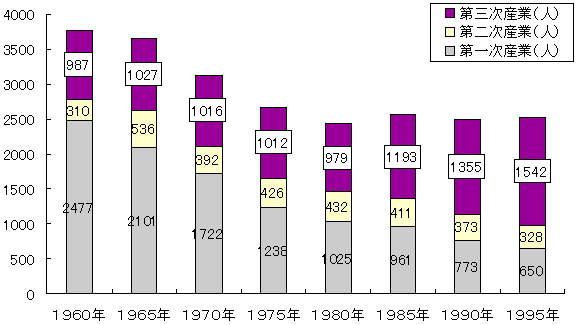3 ニセコ町の現状と課題3-5
3-5 ニセコ町の産業構造
総人口に占める就業者の割合は、高齢者人口の増加で、昭和45年54.7%、昭和50年53.6%、昭和55年53.3%と減少傾向にありましたが、昭和60年55.8%、平成2年55.4%、平成7年54.3%と回復傾向にあります。
産業別就業人口は、昭和35年から平成7年までの35年間に就業人口総数が33.2%減少しました。特に第1次産業就業者は農業就業者を中心に73.7%と著しく減少し、構成比も65.6%から25.8%と減少したのに対し、観光関連産業を主とする第3次産業者数は、総就業者数が減少する中で増加の傾向にあり、構成比では26.2%から61.2%へと増加し、昭和60年以降、第3次産業が第1次産業を上回るに至っています。基幹産業である農業と観光との結びつきは弱く、これらの連携を図ることが、地域経済活性化の方向として重要と考えられます。第2次産業就業者数は、昭和35年に310人、構成比8.2%が、平成7年328人、構成比13.0%と微増となっています。
産業別就業人口は、昭和35年から平成7年までの35年間に就業人口総数が33.2%減少しました。特に第1次産業就業者は農業就業者を中心に73.7%と著しく減少し、構成比も65.6%から25.8%と減少したのに対し、観光関連産業を主とする第3次産業者数は、総就業者数が減少する中で増加の傾向にあり、構成比では26.2%から61.2%へと増加し、昭和60年以降、第3次産業が第1次産業を上回るに至っています。基幹産業である農業と観光との結びつきは弱く、これらの連携を図ることが、地域経済活性化の方向として重要と考えられます。第2次産業就業者数は、昭和35年に310人、構成比8.2%が、平成7年328人、構成比13.0%と微増となっています。
グラフ9 産業別就業人口の推移

グラフ10 農家戸数の推移

グラフ11 農業粗生産額(棒グラフ、単位:百万円)と
農家1戸当たり生産農業所得(折れ線グラフ、単位:千円)の推移

グラフ12 観光客入込数の推移

このページの情報に関するお問い合わせ先
- ニセコ町役場
- TEL:0136-44-2121
- FAX:0136-44-3500